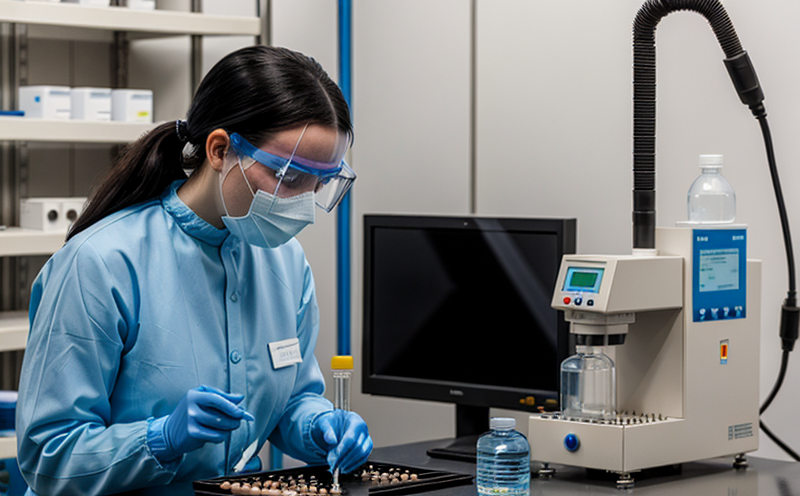USP 467 Residual Solvents Testing
The United States Pharmacopeia (USP) Chapter USP 467 provides a standardized approach to residual solvent testing, ensuring that pharmaceutical products are free from harmful solvents. This service is essential for the quality control and compliance of pharmaceuticals with regulatory standards set by USP.
The process involves identifying and quantifying volatile organic compounds (VOCs) and other potentially toxic substances present in drug formulations at levels that could affect product safety, efficacy, or stability. Residual solvents can be introduced during manufacturing processes such as extraction, crystallization, drying, or coating. These solvents must be removed to safe limits before the final formulation is released into the market.
Our laboratory adheres strictly to USP 467 guidelines, using advanced analytical techniques tailored to detect even trace amounts of residual solvents. This ensures that every batch undergoes rigorous scrutiny to meet stringent quality and safety standards.
The testing procedure typically includes sample preparation, extraction, derivatization (where necessary), injection onto a gas chromatograph equipped with flame ionization detector (GC-FID), and data analysis. The method is designed to identify over 50 different classes of solvents, including alcohols, ketones, esters, ethers, and aromatic hydrocarbons.
Understanding the types and amounts of residual solvents present helps manufacturers make informed decisions about process optimization and raw material selection. It also provides assurance that products comply with international regulations, such as those outlined in ISO, ASTM, and European Pharmacopoeia.
With over 20 years of experience in pharmaceutical testing, our team specializes in ensuring that each batch meets the highest quality standards. By partnering with us, clients can trust that their products are safe, effective, and compliant with current regulatory requirements.
| Residual Solvent Classes | Examples |
|---|---|
| Alcohols | Methanol, ethanol |
| Ketones | Benzophenone, acetone |
| Esters | Butyl acetate, ethyl formate |
| Ethers | Diethyl ether, tetrahydrofuran |
| Aromatic hydrocarbons | Toluene, benzene |
Our team of experts uses cutting-edge technology and follows strict protocols to ensure accurate results. From sample preparation through final analysis, every step is meticulously documented to provide comprehensive data supporting the quality of your pharmaceutical products.
We understand that meeting USP 467 requirements is crucial for maintaining a strong market presence. By choosing our laboratory services, you can rest assured knowing that your products are being tested with precision and accuracy, adhering strictly to international standards.
Scope and Methodology
- Sample Collection: Samples are collected from various stages of the manufacturing process. This could include raw materials, intermediates, or final products.
- Extraction: Depending on the solvent type, appropriate extraction methods may be used to recover residual solvents for analysis.
- Derivatization (if necessary): Some compounds require derivatization before they can be analyzed by GC-FID. This step ensures better detection limits and broader linear response ranges.
- Injection: The prepared samples are injected into the gas chromatograph for separation based on their volatility and polarity.
- Data Analysis: Chromatograms generated from the injection are analyzed to identify peaks corresponding to known solvents. Quantification is performed using calibration curves constructed beforehand.
The USP 467 method specifies the use of a GC-FID detector, which measures the intensity of light emitted by ions produced when solvent molecules pass through the ionization chamber. This allows for highly sensitive detection and quantification of residual solvents even at very low concentrations.
Our laboratory ensures that all instruments are calibrated regularly against certified reference materials to maintain accuracy throughout each testing cycle.
Eurolab Advantages
- Comprehensive Expertise: Our team includes chemists and engineers specializing in pharmaceutical analysis who stay current with the latest developments in technology and methodology.
- Advanced Equipment: We utilize state-of-the-art instruments capable of detecting trace levels of residual solvents, providing reliable results every time.
- Regulatory Compliance: Our procedures are designed to meet all relevant USP and other international standards, ensuring that your products remain compliant with current regulations.
- Rapid Turnaround Times: By streamlining our processes, we offer quick turnaround times without compromising on the quality of service provided.
- Cost-Effective Solutions: We strive to provide cost-effective testing services while maintaining high standards of accuracy and reliability.
- Dedicated Client Support: Our clients receive personalized attention from start to finish, ensuring that their needs are met throughout the entire testing process.
We pride ourselves on delivering exceptional service tailored specifically to your requirements. Whether you need routine testing or one-off assessments, our team is here to support you every step of the way.
Environmental and Sustainability Contributions
- Eco-Friendly Practices: Our laboratory employs environmentally friendly practices in sample preparation and disposal. This includes minimizing waste generation and using recyclable materials where possible.
- Energy Efficiency: To reduce our carbon footprint, we have implemented energy-efficient measures across all aspects of our operations, including lighting systems and heating/cooling infrastructure.
Beyond these operational improvements, our commitment to sustainability extends to the broader community. By ensuring that pharmaceutical products meet strict quality standards through thorough residual solvent testing, we contribute to public health and safety—key components in maintaining a healthy environment for all citizens worldwide.





